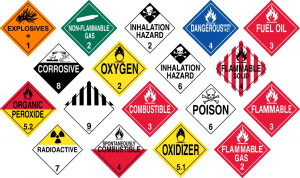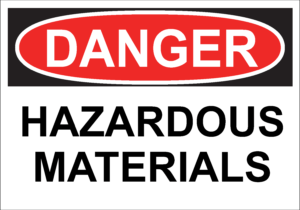Hazmat Truck Drivers Dangers: Exploring the Challenges and Rewards
Truck drivers face various dangers on the road every day, but the risks become even more significant when they are responsible for transporting hazardous materials. Due to hazmat truck drivers dangers they need specialized training, certifications, and safety precautions to handle these dangerous substances. Despite the increased risks, many hazmat drivers find the high salary and job growth potential make this career path worth the added challenges. In this article, we will explore the world of hazmat truck drivers, the dangers they face, and the potential rewards of this profession.
What are hazardous materials?

Hazardous materials are any items or agents — biological, chemical, radiological, and/or physical — which have the potential to cause harm to humans, animals, or the environment, either by itself or through interaction with other factors.
As mentioned earlier, hazardous materials are any items or agents — biological, chemical, radiological, and/or physical — which have the potential to cause harm to humans, animals, or the environment, either by itself or through interaction with other factors. These materials are regulated by various US government agencies, including the EPA, OSHA, DOT, and NRC. Each agency has its own definition and guidelines for managing hazardous materials.
Hazmat professionals and their responsibilities
Hazmat professionals are responsible for managing hazardous materials throughout their life-cycle. This includes process planning, development of new products, manufacturing, distribution, use, disposal, clean up, and remediation. They must be properly qualified and trained to handle such materials and comply with the regulations set by the governing agencies.
Enjoying our insights?
Subscribe to our newsletter to keep up with the latest industry trends and developments.
Stay Informed
Hazmat trucking: A dangerous but rewarding profession

To become a hazmat driver, one must first obtain a commercial driver’s license (CDL) and then acquire a hazmat endorsement (Code H).
Hazmat truck drivers are responsible for transporting hazardous materials safely and efficiently. They must carefully monitor their routes, adapt to changing traffic and road conditions, and follow proper safety measures at all times. The daily pressures faced by truck drivers are significantly heightened for those who transport hazardous materials.
Requirements for becoming a hazmat truck driver
To become a hazmat driver, one must first obtain a commercial driver’s license (CDL) and then acquire a hazmat endorsement (Code H). This endorsement requires additional training, passing a knowledge test, and completing a TSA background check. Many companies value hazmat drivers and may even pay for their certification due to the high demand for these professionals.
The dangers of transporting hazardous materials
Hazmat truck drivers must be familiar with the potential risks associated with transporting hazardous materials. Some of these dangers include:
- Fire: Flammable materials can ignite in accidents, posing a significant threat to everyone involved and the surrounding environment.
- Explosions: Volatile substances can cause devastating explosions, resulting in severe injuries or fatalities.
- Chemical burns: Corrosive materials can harm or kill anyone who comes into contact with them.
- Radiation: Radioactive substances can cause serious health effects, even without direct contact.
- Poison: Poisons can seep into the environment and harm people, animals, and plants over a wide area.
The rewards of hazmat truck driving
Despite the increased risks, many hazmat drivers find the rewards of their profession to be worth the challenges. With an average salary of $61,870 and a predicted 17-percent employment growth by 2026, hazmat truck driving is one of the highest-paying careers in the trucking industry.
The importance of awareness and safety

With an average salary of $61,870 and a predicted 17-percent employment growth by 2026, hazmat truck driving is one of the highest-paying careers in the trucking industry.
It is crucial for motorists to be aware of the dangers that truck drivers, especially hazmat truck drivers, face daily. An accident involving hazardous materials can have severe consequences for a large population and the environment, including plants and animals. By understanding these risks and practicing safe driving habits around trucks, both drivers and the general public can help reduce the chances of accidents involving hazardous materials.
Safety tips for sharing the road with hazmat trucks
Here are some safety tips for motorists when sharing the road with hazmat trucks:
- Maintain a safe distance: Keep a safe distance from hazmat trucks, as they require more time and space to stop or maneuver compared to regular vehicles.
- Be patient: Hazmat truck drivers may drive slower than other vehicles to ensure the safe transportation of hazardous materials. Be patient and avoid aggressive driving behaviors.
- Pass with caution: When passing a hazmat truck, make sure you have plenty of space to do so safely. Never pass on the right side, as this is the truck driver’s blind spot.
- Avoid distractions: Stay focused on the road, and avoid distractions like cell phones and other electronic devices when driving near hazmat trucks.
- Be aware of warning signs: Pay attention to any warning signs or placards on hazmat trucks, as they provide information about the hazardous materials being transported.
Continuous training and preparedness

Hazmat truck drivers must undergo continuous training to stay up-to-date with new regulations, technologies, and best practices for handling and transporting hazardous materials.
Hazmat truck drivers must undergo continuous training to stay up-to-date with new regulations, technologies, and best practices for handling and transporting hazardous materials. This ongoing education helps ensure they are prepared to handle emergencies and respond appropriately in case of an accident.
Conclusion
Hazmat truck drivers face many dangers while transporting hazardous materials, making their job one of the most challenging in the trucking industry. However, the high salary and job growth potential make this career path appealing for many drivers. With proper training, safety precautions, and increased awareness among the general public, the risks associated with transporting hazardous materials can be minimized, ensuring the safety of hazmat drivers and everyone on the road.
For more News on Hazmat and Hazardous Material Transport Go Here
Explore Hazmat Transportation: Comprehensive Resources on Regulations and Responsibilities
These external resources offer in-depth information on hazardous materials transportation, associated regulations, and the crucial role of hazmat truck drivers:
- U.S. Environmental Protection Agency (EPA) – https://www.epa.gov/hazmat-spills-chemical-releases
- U.S. Occupational Safety and Health Administration (OSHA) – https://www.osha.gov/SLTC/hazardouswaste/
- Federal Motor Carrier Safety Administration (FMCSA) – https://www.fmcsa.dot.gov/regulations/hazardous-materials
- U.S. Nuclear Regulation Commission (NRC) – https://www.nrc.gov/materials.html
- Institute of Hazardous Materials Management (IHMM) – https://ihmm.org/
- Pipeline and Hazardous Materials Safety Administration regulations (49 CFR 100-199) – https://www.ecfr.gov/current/title-49/subtitle-B/chapter-I
- Bureau of Labor Statistics (BLS) – https://www.bls.gov/oes/current/oes533032.htm




















